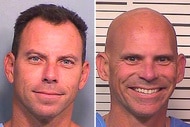Create a free profile to get unlimited access to exclusive videos, breaking news, sweepstakes, and more!
Inmate Suspected Of Killing 'Eleven Who Went To Heaven' Dies In Prison, Leaving Unanswered Questions
“Today these girls may finally rest in peace because their killer has gone to hell,” one investigator wrote after hearing the news of Edward Harold Bell's death.

A convicted murderer suspected of killing 11 girls in Texas died Saturday morning in prison, taking any information he may have had about the young girls’ deaths with him.
Edward Harold Bell, who was serving time for the 1978 killing of an ex-Marine, collapsed and died in the Wallace Pack Unit in Navasota at the age of 82.
Texas Department of Criminal Justice spokesman Jeremy Desel told the Associated Press that no foul play was suspected in Bell’s death, however he declined to discuss any specifics of how he died due to medical privacy laws.
Although Bell was serving a 70-year sentence for killing Larry Dickens, an ex-Marine who was shot after confronting Bell for exposing himself to a group of neighborhood girls, he’s long been suspected of other murders as well.
In 2011, he wrote the Houston Chronicle claiming to have killed a string of girls he referred to as “Eleven who went to Heaven” in Dickinson, Houston, Clear Lake and Alvin, Texas, the paper reports.
In the letters, he also told the paper that he had admitted to some of the same murders to prosecutors in Galveston and Harris counties in 1998, but he was never charged after prosecutors were unable to find any direct evidence to link him to the crimes.
The claims were later explored in the 2017 A&E series “The Eleven,” which followed the efforts of Houston Chronicle investigative journalist Lise Olsen and former Galveston homicide detective Fred Paige as they tried to determine whether there was any truth to the claims.
The pair was able to uncover circumstantial evidence that linked Bell to the crimes, but found no definitive proof. They were able to determine that Bell often had access to the areas where the crimes were committed and also found that witnesses saw two of the missing girls get into a van that matched the description of one Bell owned at the time, Houston Matters reports.
His confession letter written to prosecutors in the 1990s also had names and details of the killings that suggested he could have been the killer, but Bell would later go on to deny his involvement in the murders.
In a prison interview with Houston Matters in 2017, Bell claimed he had admitted to the murders because he had been suicidal.
“I was going to let the state kill me,” he said.
Many believe he was involved the killings.
Galveston prosecutors reopened the murder cases of two of the girls, Debbie Ackerman and Maria Johnson, in recent years, but never filed any charges against Bell before his death. He remained the key suspect in the murders.
After his death was announced, Galveston Police Officer Michelle Sollenberger wrote on Facebook, “Today these girls may finally rest in peace because their killer has gone to hell,” the Chronicle reports. She had been an investigator on the case in recent years.
Rita Brestrup, a sister of victim Maria Johnson, also believes he was responsible for taking the life of her sibling in 1971.
“I believe he took a life precious to me and my life has never been the same since,” she said. “Maria’s death impacted my life more than any other single event. Nothing can take her memory away.”
Now that Bell has died, some are hopeful additional witnesses may come forward with information about the cases.
“People were afraid of him,” Olsen told Houston Matters. “And there were some people who would never talk to me because they were afraid of him — they were afraid that he might get out.”
Bell had been on the run for 14 years after shooting Dickens, and was eventually found living at a Panama yacht club in 1993 with a teenage girl. The case was featured on a 1992 episode of “Unsolved Mysteries” that also earned Matthew McConaughey his first TV acting credit for playing Dickens in the re-enactment of the crime.






















